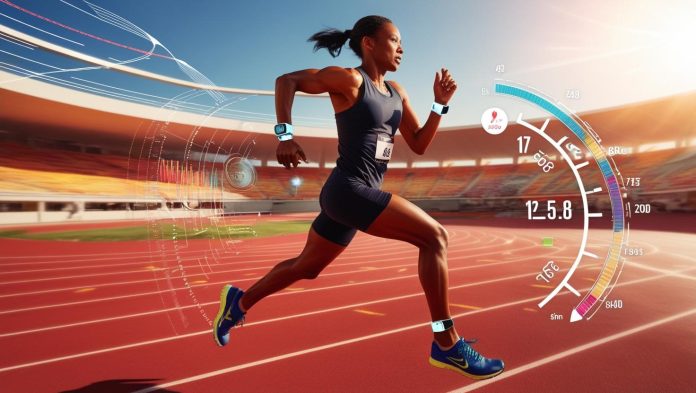As an Olympic contender zones in before the final show, a marathoner gears up for the big run, or pro squads circle up for game plans, a hidden shift is underway. It’s not just about coach guidance or years of practice now. Athletes from all over are turning to nifty gadgets on their wrists sewn into their kits, or tucked into their gear for some pretty accurate numbers.
These gadgets are shaking things up big time for how sports folks train up, bounce back, and bring their A-game. The blend of sporty smarts and techy tweaks is one major leap for the sports world in the last ten years—it’s like blending muscle with microchips and it’s taking what folks can do to a whole new level.
This piece digs into how wearable tech is shaking up the way athletes prep for competition in loads of sports, what this means for their game, and the expectations as these gadgets keep getting better.

The Progression in How We Measure Athletes Swapping Stopwatches for High-Tech Gadgets
For ages, coaches have leaned on basic stuff: stopwatches just watching, and what the athlete says. Training was kinda like art meets science, with seasoned coaches getting a knack for spotting the good moves and signs of strong play.
“The big hurdle was always what we could see,” says Dr. James Harrington, the head honcho of Sports Science at the Elite Performance Institute. “Even a top-notch coach can’t catch every little thing, plus how hard athletes think they’re working or how beat they are can be way off.”
Back in the ’80s, the first major wearable tech—like heartbeat monitors—gave folks a single number that shed light on how much stress the heart was under. Fast-forward to the early 2000s, and we started to see GPS help understand basic moves. But nowadays, we’ve jumped huge into what’s known as the “quantified athlete,” thanks to these super advanced wearable ecosystems.
The Big Shift with Data
Top-notch athletes today crank out crazy amounts of training stats. Imagine this: just one pro basketball player can create upwards of 1 million bits of info in a normal practice, all thanks to different wearable gadgets. We’re not just talking about simple things like heart rates or steps here.
- Exact control and different ways to move
- Muscles get going when you do stuff
- How the ground pushes back and how hard that feels
- How well the body uses energy and what it uses for fuel
- Stuff that tells you how well you bounced back, like how you sleep
- Signs your muscles are super tired
- When your body moves funny because something’s off
All this info kinda mixes up how athletes, their trainers, and their workouts all hang out together.
Sporty Gadgets That Are Changing
How Athletes Train Super Cool Gear for Upgrading Performance
Right now, there are tons of athletic gadgets. They’re so much more than those step-counting things everyone’s got. Top-notch players are all about these fancy setups, like:
-
Super Smart Body-Watching Gadgets
Gadgets such as the Whoop strap and Oura ring keep a watchful eye on your heart’s variability how well you sleep, your breathing rate, and if you’re bouncing back okay. These numbers make it super clear when to turn up or dial down workout heaps super important to dodge too much training while still getting the best gains.
The Boston Red Sox grabbed the spotlight as the top dogs in MLB to kick off Whoop tracking for their whole squad. They shout out to this smart tech for helping them cut down on injuries and stepping up their game.
-
Biomechanical Analysis Systems
Fancy tech wearables for motion like Catapult’s OptimEye and STATSports’ Apex gadget track how you move with mad accuracy. These cool tools check out:
- Forces of speeding up and slowing down
- How high someone jumps and how they land
- The strength of making cuts and switching directions
- Steps traits and how well someone runs
- Signature moves in different sports
Dr. Sarah Kim, the big boss of Biomechanics at the Central Sports Research Institute, says, “The cool thing about the new gear is it spots tiny changes in how you move that can tell us you might get hurt before it happens. It has an influence on finding issues with how an athlete moves ’cause of being tired, way before they start to feel ouch.”
-
Gear with Fancy Fibers and Sneaky Sensors
Sticking sensors right into sports clothes is like the super-new thing in gear that you can wear. Companies, like Athos, are out front making tight outfits with sneaky EMG (that’s electromyography) sensors inside checking on muscles to see how they’re doing while you’re moving, and all of it in the moment.
These slick fabrics can spot:
- Which muscles activate and their sequence
- Differences in muscle recruitment on the left and right
- How force is produced in movement chains
- Signs of compensation pointing to injury risk
-
Neural Training Systems
Wearables that are super futuristic aim to track and boost the brain parts involved in athletic performance. Gadgets like Halo Sport apply a technique that stimulates brain areas during practice sessions to maybe speed up the learning of how to move.
“Digging into the brain side of sports performance is like exploring unknown territory,” says sports brain scientist Dr. Michael Freeman. “We’re at the start of getting how gadgets can enhance stuff like quick reactions and smart choices when stressed.”

Training Ways Changing Due to Actual Use
Tailoring Workouts to Each Person
Wearable tech has kicked off a trend of super personalized training routines. Each athlete is different, so a training method may rock for one and flop for another.
This is how Olympic swim coach Teresa Valenti throws it down: “Before wearables, we might have the entire team do the same workout. Now, we can see that one swimmer reaches optimal training stimulus after 6 high-intensity intervals while another might need 9. Some athletes recover in 36 hours, others need 72. That precision is transformative.”
This tailor-made approach also takes a swing at:
-
Load Management Causing a Revolution
Major league teams are now using some smart systems for managing player stress, thanks to data collected from techy gadgets they wear. When the Toronto Raptors took the championship with Kawhi Leonard, they showed the world that timely breaks guided by this wearable info, could keep a player sharp for the big games.
NBA strength trainer Marcus Williams breaks it down like this: “It’s not just about how much they do,” he says. “These gadgets give us the lowdown on the type of stress ballers go through too. Like, a player might be okay with running lots but could have trouble with too many slam dunks. We didn’t have those deets in the old days.”
-
Getting Better with On-The-Spot Tips
Wearable tech now gives instant feedback when someone is practicing a skill, so they can tweak their technique on the spot. Olympic throwers of the javelin strap on arm sensors to catch the precise angles and strength they release at, while swimmers get straight-up stroke analysis after finishing each lap in the pool.
Baseball pitching pro Jennifer Zhao points out, “Instead of waiting days or weeks, athletes now get feedback in just seconds.” She highlights how a pitcher can adjust their throw a bit and spot the influence on ball spin and where it gets released straight away.
-
Avoiding Hurt by Noticing Patterns
Spotting patterns to prevent getting hurt might be the top use of this gear. By knowing an athlete’s usual movements, the tech can warn athletes and their coaches if something’s off that could mean a higher chance of injury.
Premier League football teams now use tech to keep tabs on leg muscle imbalances, which is a big clue for injuries that happen without contact. If the patterns of how a player moves start looking dodgy, they can change up the training to nip problems in the bud before any actual hurt shows up.
The money part’s pretty huge. Looking at five pro soccer squads in Europe, a bit of research figured out that using tech you can wear to stop injuries from happening saved about €1.4 mil for each team every year.
What’s Next for Wearables in Sports Training
As cool as the tech we’ve got now is, this stuff’s just getting started. There’s a bunch of new gear on the horizon that’s set to mix things up big time for how athletes train in the next few years:
-
Systems that Watch What’s in Your Body
Wearables coming up next are gonna track more than just heartbeats and footsteps. They’re working on these newfangled sweat patches that check on stuff like salt in your sweat, the acid that builds up when your muscles work hard, and even things that show if you’re stressed or not.
Dr. Thomas Wright, who knows a ton about how bodies work when you exercise reckons, “When we start to monitor biochemical stuff as it happens, we’re gonna be super accurate with training.” He’s all, “Picture being clued-in on when you’re running out of fuel or when stress hormones are messing with your chill time.”
-
Smart AI Stuff Team-Up
The real deal with these gadgets is how they team up with smart AI. This AI is like a super-brain that digs through tons of workout and game data. It’s all about spotting tricky patterns between how athletes train and how well they do, stuff that would miss a regular coach’s eye.
Many Olympic training hubs are crafting “AI” platforms. These mix data from wearables with outcomes of performance to craft more advanced predictive models for better training.

A Case Study: The Runner Wired Up
Pro marathoner Elena Rodriguez’s shift to data shows the full effect of putting wearable tech into play:
Elena used to stick to old-school marathon prep tactics. But she hit a wall with her scores for three years. So, she switched to a data-packed wearable strategy:
- Kick-off every morning: Measures of HRV and how well you slept set the day’s workout power.
- Metrics for your runs: Sensors that check your stride tell you straight up if you’re running efficiently.
- Making the most of recovery: Watching things in the evening helps time your meals and pick the best way to bounce back.
- Keeping your form right: Heads-up for when you’re tired and your running form starts to slip on long runs.
- Eye on your progress: Tests you do every week to show how much your body’s fitness is improving.
Rodriguez saw some serious changes. Over a year and a half, she shaved off 7:43 from her marathon best. That’s huge after being stuck in the same spot for so long.
Rodriguez says, “The technology wiped out the guessing game.” “Rather than powering through workouts when my body wasn’t up for it, I got smart about altering my daily exercise to match how my body was feeling. The numbers told me the right times for going hard and the moments to take it easy, in a way my own feelings never could.”
Limitations and Ethical Issues
The wearable revolution presents significant questions for the sports community despite its transformative potential:
-
Competitive equity and accessibility
As wearable technology advances, wealthy teams and countries may be able to gain a competitive edge due to its rising cost. Advanced systems utilized by elite programs can cost hundreds of thousands of dollars a year, while basic wearables are now reasonably priced.
Dr. Marcus Hendricks, a sports ethicist, cautions that “we’re creating a potential technological divide in sports.” “Those without access to advanced systems may fall behind when data becomes a competitive advantage.”
-
Data Ownership and Athlete Autonomy
As wearables collect increasingly personal biological data, questions of ownership and privacy become critical. Who is in charge of an athlete’s physiological information? Is it possible for teams to need constant oversight even when they’re not working? How should private health data found via wearable technology be managed? A number of player associations have started to negotiate clauses in collective bargaining that specifically address wearable data rights and usage restrictions. 3. The Human Factor The preservation of the human element in coaching and athletic development is arguably the most philosophical issue. Some worry that the psychological and intuitive components of sports training may be lost as choices become more and more data-driven. Veteran track coach Carlos Mendez contends that “algorithms cannot replace the art of coaching.” “The best implementations use technology to strengthen the relationship between the coach and the athlete, not to replace it.”
Conclusion: The New Sports Collaboration
Athletes and wearable technology have a new kind of partnership in which technology is used to explore and expand human potential. Wearable technology acts as an amplifier, enabling athletes to train more effectively and intelligently than ever before, rather than taking the place of the core athletic attributes of talent, discipline, and competitive drive. “Technology doesn’t make the athlete,” says swimmer Michael Jensen, an Olympic gold medallist. It shows you what kind of athlete you can be.
Sports training is clearly going through a quiet revolution that feels like it’s only picking up pace. Athletic performance now isn’t just about more sweat and longer hours—it’s about clever strategies and a smart mix of effort and digital know-how. In everyday terms, our ideas of physical limits are being redrawn through a blend of raw drive and the latest tech insights, even as wearable devices get ever more intricate, personalized, and snugly woven into training routines.
Nowadays, when it seems like tech and sports are merging more than ever, taking a closer look at wearables in athlete training reveals unexpected ways to boost performance at nearly every competitive level. In most cases, this isn’t merely a trend; it’s a transformation that quietly opens fresh avenues for pushing human achievements further than we once thought possible.
